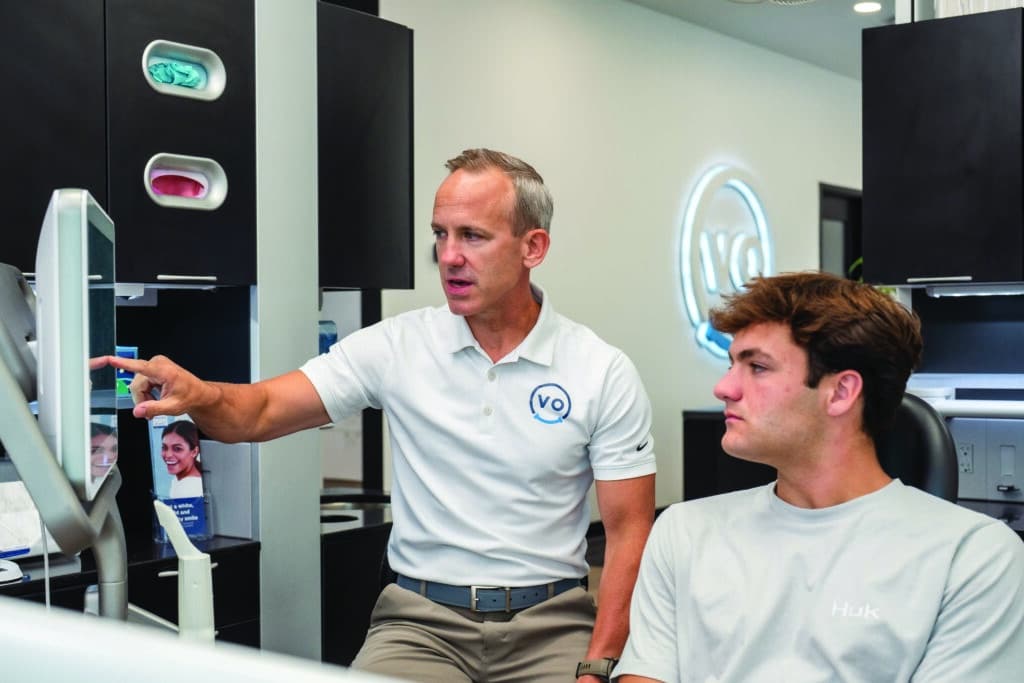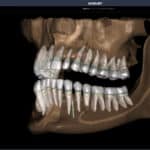From remote monitoring to AI-driven workflows, Drs Zachary Varble and Adam Reynolds discuss how they’re rethinking care delivery and practice operations.
By Orthodontic Products Staff
As the orthodontic landscape continues to evolve, private practice owners are under increasing pressure to adapt—not only to emerging technologies, but also to shifting patient expectations and operational challenges. The rise of artificial intelligence, digital workflows, and remote monitoring is changing how care is delivered, while labor shortages and economic pressures are forcing practices to rethink how they operate. At the same time, today’s patients are demanding greater convenience, flexibility, and ongoing digital communication.
To explore how private practices can prepare for what’s next, Orthodontic Products spoke with Zachary Varble, DMD, MSD, of Varble Orthodontics in Creve Coeur, Mo, and Adam Reynolds, DMD, MS, of Orthodontic Design Co in Madison, Ala. Both orthodontists have actively embraced change in their practices—leveraging digital tools, refining workflows, and rethinking how they connect with patients. In this conversation, they share what they see coming, how they’re responding, and what advice they have for their peers.
Orthodontic Products: What changes do you see coming that orthodontic practices can’t afford to ignore in the next 5 to 10 years?
Zachary Varble, DMD, MSD: This is THE question. I can think of three changes on the horizon, with artificial intelligence (AI) being the common factor between them.
First, remote monitoring is transforming the way we deliver care. What used to require in-office visits can now be managed virtually with AI-supported platforms like DentalMonitoring, allowing us to observe patients weekly, catch issues early, and guide treatment dynamically without interrupting their lives. This isn’t just a scheduling convenience—it’s a paradigm shift in care delivery, where the orthodontist becomes accessible, proactive, and more precise thanks to digital tools. Add to that the evolution of AI-assisted digital setups for both aligners and braces, and you begin to see how automation and remote connectivity will define the next generation of orthodontic care.
Second, we’re experiencing a major shift in consumer mindset driven by the efficiencies of AI tools. Patients, especially busy adults and parents, are prioritizing convenience, flexibility, and a frictionless experience. The value equation has changed—people want outcomes, but they also want them delivered in a way that fits their lifestyle. Orthodontists who understand this and build patient-centric, tech-enabled systems will stand out in a crowded market.
Third, economic and labor pressures are forcing practices to become more agile, and I believe AI tools will help with this. With staffing challenges and rising overhead, practices must tighten their workflows, cross-train teams, and leverage digital tools to do more with less. Efficiency, adaptability, and clear internal systems are no longer luxuries—they’re survival tools.
Adam Reynolds, DMD, MS: Embracing custom solutions and digital planning is one area that will continue to grow and become the standard of care in the future. This is fully manifested in the aligner portion of our practices. It has taken longer for these tools and systems to be developed in the digital and custom braces arena—especially ones that orthodontists are willing to adopt. However, after using KLOwen over the last few years, I believe the price point and the efficiency is there and this kind of system can change the way we treat patients. There are other systems out there, and I think adopting and refining a chosen system will become necessary in the future. Long term, it will become harder to ignore these advancements. Many are already adopting this way of practice and seeing its benefits for patients and the practice.
Secondly, orthodontics has been slow to fully utilize the benefit of the powerful tool that virtually every patient has: the cell phone. Remote monitoring is still in its infancy and yet, as I use the Grin remote monitoring system in my practice, I have seen my patients experience significant benefits. It has completely changed the way we practice, schedule, and communicate with our patients, and how we think about their journey.

As Adam Reynolds, DMD, MS, sees it, AI will push orthodontic practices to build systems—including automations—that take full advantage of emerging tools, allowing the orthodontic team to focus on patients rather than administrative tasks. Photo courtesy of Dr Adam Reynolds.
OP: How are you preparing your practice to navigate evolving patient expectations around convenience, technology, and communication?
Varble: We’ve embraced the shift in patient expectations by redesigning our entire model around accessibility, flexibility, and value. Today’s patients want results—but they also want those results delivered in a way that doesn’t disrupt their daily lives. Our answer to that has been a strategic investment in remote monitoring.
Through DentalMonitoring, we’re able to observe patients weekly without the need for in-office visits—giving them peace of mind, real-time feedback, and a sense of continual progress. It’s one of the most powerful ways we’ve met the demand for convenience without compromising clinical oversight. In fact, we’ve found that it enhances the quality of care because we can catch issues early and adjust before problems escalate.
Reynolds: We all communicate constantly and asynchronously through text, photos, videos, and emojis. I see how my kids and these younger generations communicate. I can barely get them to pick up a phone call! Even email has become similar to your mailbox at home where the vast majority of what you get is junk and unimportant.
For us, using a platform like the Grin app has been a game changer. We are holding the patient’s hand through their journey. They are regularly sending us photos, videos, and questions throughout their care. As an orthodontist, photos and videos are truly worth more than a thousand words when the patient is communicating to us. On the patient side, they have told us that they feel MORE connected to our practice because of their ability to send us a text message through the app and get a timely response 7 days a week. This feeling of “warm care” through technology can seem counterintuitive. We often aren’t seeing patients for several months. The worry for us doctors is that we think WE are the important feature in a relationship. However, what patients really want is clear, easy, convenient, asynchronous communication. And they want it instantaneously. Grin has checked all those boxes for us. For as much as we love to see our patients and interact with them, the reality is that it is not convenient for anyone to make it to a doctor’s office for an appointment in the middle of the day.
OP: What role do you think AI and digital tools will play in clinical workflows and practice management moving forward?
Varble: AI and digital tools are becoming essential—not just to enhance what we do, but to redefine how we do it.
Clinically, AI is already helping us make better, faster, and more informed decisions. With tools like DentalMonitoring, we’re no longer guessing whether treatment is tracking properly—we’re seeing progress in real time, intervening early, and keeping patients on course. I can also see AI becoming increasingly important in digital setups, helping us refine aligner staging and even guide bracket-based treatment in ways that are more predictable and consistent.
But AI’s role goes beyond the clinical. Tools like large language models (LLMs) are beginning to play a major role in how we communicate with patients and manage information. From crafting personalized, automated messages to helping our team explain complex ideas more clearly and consistently, these tools streamline communication and reduce the cognitive load on our staff.
They also support administrative tasks, training materials, and even content creation—so our team can focus more on what really matters: the patient experience.
What excites me most is that AI and automation aren’t replacing our team—they’re elevating their impact. By handling the routine and the repetitive, these tools free our people up to do what humans do best: connect, educate, and care.
Reynolds: My personal opinion is that AI will become a powerful tool in creating efficiencies for myself and my team. I may be wrong, but I just don’t see it replacing people. Personal connections have real value. I believe they have become even more valuable in recent times as we all struggle to find personal connections in a digital age. However, I predict that AI will allow a business and its team to be able to accomplish more while also being available to connect with more people.
I think the challenge will be for companies to find ways to integrate AI into their software in meaningful and useful ways for businesses. On the other hand, for small businesses like an orthodontic office, it will require rethinking how you want your systems to be set up to take advantage of those technologies—for example, how do you want to develop automations and how do you leverage your great team to be patient-facing instead of task-burdened.

For Zachary Varble, DMD, MSD, innovation isn’t a departure from clinical philosophy—it’s a way to scale it with greater consistency, control, and personalized care. Photo courtesy of Dr Zachary Varble.
OP: What advice would you give to other orthodontists who feel hesitant or overwhelmed by the pace of change in the industry?
Varble: I get it—change can feel overwhelming. But I genuinely believe we’re living in the golden age of orthodontics. There has never been a better time to be in this profession—not just for orthodontists, but for our teams and our patients. The tools, technology, and resources available to us today give us the power to deliver care that is faster, more flexible, and more personalized than ever before.
That said, it’s normal to feel paralyzed by all the options and expectations. When that happens, I always come back to one principle: constraint. In business, a constraint is the bottleneck that limits your performance or progress. It could be time, staffing, scheduling capacity, communication breakdowns—whatever is holding you back.
Good leaders don’t ignore constraints—they identify them, and then allocate their energy and resources to remove or work around them. Instead of trying to fix everything at once, focus on one constraint at a time. Solve that, then move to the next. That’s how real transformation happens: one focused system improvement at a time.
Also, remind yourself that you don’t have to do it alone. Some of the best changes I’ve made have come from visiting other offices, attending CE courses, mastermind groups, or simply having open conversations with peers. You’re not falling behind—you’re just one new perspective away from a breakthrough.
What’s exciting is that today’s changes aren’t just about keeping up—they’re about building something better. For you, your team, and your patients. If you embrace the mindset that constraint breeds creativity—and that this is a season of opportunity—you’ll find your way forward. This really is the best time to be in orthodontics, if you’re willing to evolve.
Reynolds: For those starting a practice, it is a wonderful time! You can shape your practice from the beginning to take advantage of these technologies and tools and outsourcing to be efficient and intentional from the beginning.
For other practices, it takes a conscious decision to change and then to stick to it. There will inevitably be bumps along the way and it may take a re-thinking of all your systems—everything from appointment times, scheduling templates, to roles and responsibilities.
I think in any situation the two critical ingredients are: the doctor/owner having a clear vision of what they want the practice to be and regular team meetings that are more than a lunchtime sit-down. In those meetings, the owner can pass on that vision to the team and the whole team can be honest and open about what is working and not working. From there, everyone knows they have an opportunity to work together to figure out solutions or adjust systems.
OP: How do you balance staying true to your clinical philosophy while also evolving your business model to meet future demands?
Varble: To me, the goal has never been to sacrifice clinical philosophy for innovation—it’s been to refine it through innovation.
My clinical philosophy has always centered on delivering high-quality, personalized, and efficient care. Everything we’ve implemented has allowed us to scale that philosophy with more consistency and control. These tools don’t dilute our standards—they reinforce them.
For example, remote monitoring hasn’t made us less involved—it’s made us more connected to our patients in real time, allowing us to spot issues early, offer proactive guidance, and deliver a better outcome without burdening the patient’s schedule. That aligns perfectly with our core value of maximizing both clinical excellence and convenience.
Likewise, investing in team development and smarter systems has made our office more resilient, more aligned, and more patient-focused.
So for me, the balance comes down to this: the tools have changed, but the “why” has stayed the same. And in many ways, we’re able to live that “why” more fully now than ever before.
Reynolds: For me personally, being willing to learn is a critical component. I believe that most of us are average orthodontists. I fit into that category because I think the average orthodontist does a great job. Like many, I feel that I am doing my best for my patients, and yet I learn so much as I rub shoulders with others and I continue to change what I do as I learn from them.
Of course there are core principles of orthodontics and we all desire consistent and good results for our patients. But the tools, plan of action and journey are quite adaptable if you are humble and open to ideas. I have been willing to try things a little differently because I enjoy learning. I think this can also apply for our business model. There is more than one successful business model for orthodontics. One of the challenges for an orthodontist or business is to clearly define your vision of what you want to be and then not get distracted by the many other great ways of running a business or treating a case. Making sure both of those things align is one of the critical roles of an owner-doctor. OP










